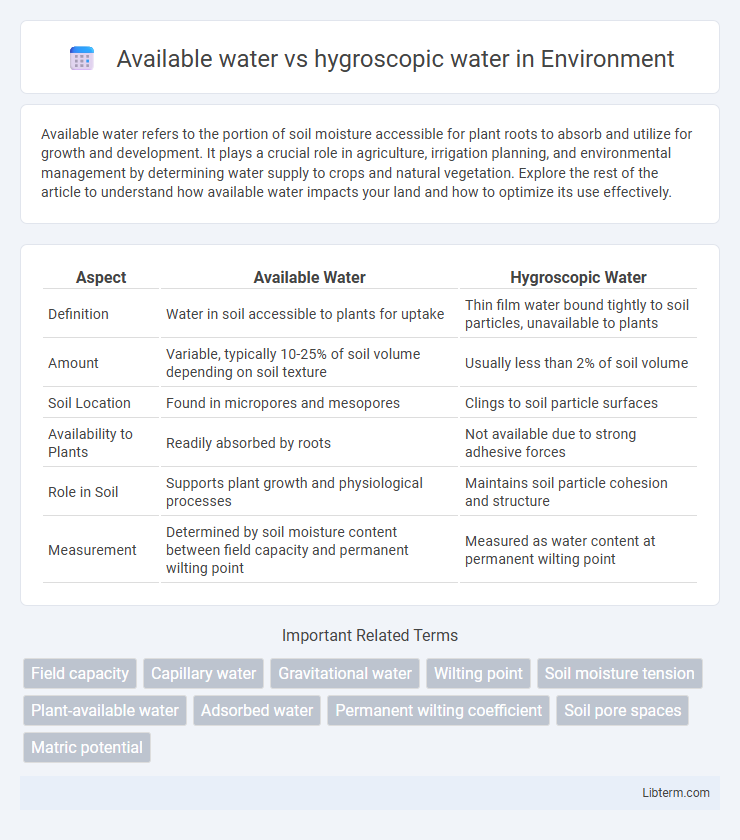Available water refers to the portion of soil moisture accessible for plant roots to absorb and utilize for growth and development. It plays a crucial role in agriculture, irrigation planning, and environmental management by determining water supply to crops and natural vegetation. Explore the rest of the article to understand how available water impacts your land and how to optimize its use effectively.
Table of Comparison
| Aspect | Available Water | Hygroscopic Water |
|---|---|---|
| Definition | Water in soil accessible to plants for uptake | Thin film water bound tightly to soil particles, unavailable to plants |
| Amount | Variable, typically 10-25% of soil volume depending on soil texture | Usually less than 2% of soil volume |
| Soil Location | Found in micropores and mesopores | Clings to soil particle surfaces |
| Availability to Plants | Readily absorbed by roots | Not available due to strong adhesive forces |
| Role in Soil | Supports plant growth and physiological processes | Maintains soil particle cohesion and structure |
| Measurement | Determined by soil moisture content between field capacity and permanent wilting point | Measured as water content at permanent wilting point |
Introduction to Soil Water Types
Available water in soil refers to the portion of water held between field capacity and permanent wilting point that plants can absorb for growth, whereas hygroscopic water forms a thin film tightly bound to soil particles, making it unavailable to plants. This distinction is crucial for understanding water retention and plant water uptake in different soil textures and conditions. Soil water types directly influence irrigation practices and crop yield by determining water accessibility to roots.
Definition of Available Water
Available water refers to the portion of soil moisture that can be absorbed and utilized by plants, typically held between field capacity and permanent wilting point. Hygroscopic water is tightly bound to soil particles and unavailable for plant uptake, remaining as a thin film around soil grains. The difference in energy levels between these two types of water determines their availability for plant growth and soil microbial activity.
Definition of Hygroscopic Water
Hygroscopic water refers to the thin layer of water molecules that tightly adhere to soil particles and is unavailable for plant uptake due to its strong adhesion. Available water, in contrast, represents the soil moisture accessible to plants, typically found between field capacity and permanent wilting point. The distinct boundary of hygroscopic water highlights its critical role in defining water retention properties and root water absorption in soils.
Differences Between Available and Hygroscopic Water
Available water refers to the soil moisture accessible to plants for uptake, typically held in the soil pores between field capacity and wilting point. Hygroscopic water is a thin film of water tightly bound to soil particles, unavailable to plants due to strong adhesion forces. The primary difference lies in their availability: available water supports plant growth, while hygroscopic water remains inaccessible despite being present in the soil.
Importance of Available Water for Plant Growth
Available water is the moisture in soil that plants can readily absorb through their roots, essential for photosynthesis, nutrient uptake, and cellular functions. Hygroscopic water forms a thin film around soil particles and is unavailable to plants due to strong adhesion, limiting its role in plant hydration. Ensuring optimal levels of available water is crucial for healthy plant growth and maximizing agricultural productivity.
Role of Hygroscopic Water in Soil
Hygroscopic water forms a thin film around soil particles and is tightly bound, making it unavailable for plant uptake, while available water is held in the soil pores and can be absorbed by roots. Although hygroscopic water does not directly contribute to plant hydration, it plays a crucial role in maintaining soil moisture equilibrium and preventing rapid evaporation. Its presence influences soil microenvironment and microbial activity, indirectly supporting soil health and plant growth.
Factors Affecting Available Water Content
Available water content in soil is influenced by factors such as soil texture, organic matter, and pore size distribution, which determine the soil's ability to retain water accessible to plants. Hygroscopic water, tightly bound to soil particles, remains unavailable for plant uptake due to strong adhesive forces. Soil structure and mineral composition further affect the balance between available and hygroscopic water by altering water retention capacity and evaporation rates.
Measurement Methods for Soil Water
Available water is typically measured using pressure plate apparatus or tensiometers that determine soil water retention at field capacity and wilting point, reflecting plant-accessible moisture. Hygroscopic water, which forms a thin film tightly bound to soil particles, is quantified by oven-drying soil samples at 105degC and calculating the residual moisture content that remains unavailable to plants. These measurement methods distinguish between soil water fractions critical for irrigation management and soil health analysis.
Impact of Soil Texture on Water Availability
Soil texture significantly impacts the proportion of available water versus hygroscopic water, as sandy soils typically hold less available water but more hygroscopic water compared to clay soils. Clay soils, with their finer particles and larger surface area, retain more hygroscopic water tightly bound to soil particles, making it unavailable for plant uptake while increasing total water retention. The balance between soil texture and water availability determines plant growth potential, as loam soils offer an optimal mix of available water and manageable hygroscopic water levels.
Strategies to Enhance Available Water in Soil
Available water in soil refers to the moisture accessible for plant uptake, typically held between field capacity and permanent wilting point, whereas hygroscopic water forms a thin layer around soil particles, unavailable to plants due to strong adhesion. Strategies to enhance available water involve improving soil structure through organic matter incorporation, which increases water retention and porosity, and adopting conservation tillage to reduce evaporation and maintain moisture levels. Implementing mulching techniques also minimizes surface evaporation and stabilizes soil temperature, further optimizing water availability for crops.
Available water Infographic

 libterm.com
libterm.com